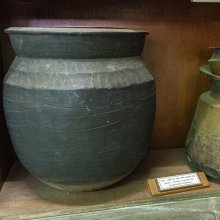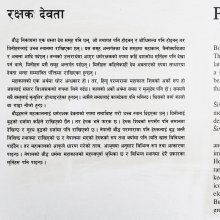Parna, Parṇa, Pārṇa: 20 definitions
Introduction:
Parna means something in Buddhism, Pali, Hinduism, Sanskrit, Marathi, Hindi, biology. If you want to know the exact meaning, history, etymology or English translation of this term then check out the descriptions on this page. Add your comment or reference to a book if you want to contribute to this summary article.
Images (photo gallery)
In Hinduism
Ayurveda (science of life)
Nighantu (Synonyms and Characteristics of Drugs and technical terms)
Source: Wisdom Library: Raj NighantuParṇa (पर्ण) refers to the “leaves” of a tree or plant, as mentioned in a list of seven synonyms, according to the second chapter (dharaṇyādi-varga) of the 13th-century Raj Nighantu or Rājanighaṇṭu (an Ayurvedic encyclopedia). The Dharaṇyādi-varga covers the lands, soil, mountains, jungles and vegetation’s relations between trees [viz., Parṇa] and plants and substances, with their various kinds.
Unclassified Ayurveda definitions
Source: archive.org: Vagbhata’s Ashtanga Hridaya Samhita (first 5 chapters)Parṇa (पर्ण) refers to “leaves”, as mentioned in verse 5.6-8 of the Aṣṭāṅgahṛdayasaṃhitā (Sūtrasthāna) by Vāgbhaṭa.—Accordingly, “[...] Not shall one drink (water that is) turbid and covered (āstṛta) with mud, tape-grass, grass, and leaves [viz., parṇa], unseen by sun, moon, and wind, rained upon, thick, heavy, [...]: (such water) one shall not drink”.

Āyurveda (आयुर्वेद, ayurveda) is a branch of Indian science dealing with medicine, herbalism, taxology, anatomy, surgery, alchemy and related topics. Traditional practice of Āyurveda in ancient India dates back to at least the first millenium BC. Literature is commonly written in Sanskrit using various poetic metres.
Jyotisha (astronomy and astrology)
Source: Wisdom Library: Brihat Samhita by VarahamihiraParṇa (पर्ण) [or Parṇaśabara?] refers to a country belonging to “Āgneyī (south-eastern division)” classified under the constellations of Āśleṣā, Maghā and Pūrvaphālguni, according to the system of Kūrmavibhāga, according to the Bṛhatsaṃhitā (chapter 14), an encyclopedic Sanskrit work written by Varāhamihira mainly focusing on the science of ancient Indian astronomy astronomy (Jyotiṣa).—Accordingly, “The countries of the Earth beginning from the centre of Bhāratavarṣa and going round the east, south-east, south, etc., are divided into 9 divisions corresponding to the 27 lunar asterisms at the rate of 3 for each division and beginning from Kṛttikā. The constellations of Āśleṣā, Maghā and Pūrvaphālguni represent the south-eastern division consisting of [i.e., Parṇa, Śabara] [...]”.

Jyotisha (ज्योतिष, jyotiṣa or jyotish) refers to ‘astronomy’ or “Vedic astrology” and represents the fifth of the six Vedangas (additional sciences to be studied along with the Vedas). Jyotisha concerns itself with the study and prediction of the movements of celestial bodies, in order to calculate the auspicious time for rituals and ceremonies.
Purana and Itihasa (epic history)
Source: archive.org: Shiva Purana - English TranslationParṇa (पर्ण) refers to “leaves”, according to the Śivapurāṇa 2.3.22 (“Description of Pārvatī’s penance”).—Accordingly, as Pārvatī performed her penance: “[...] Different sorts of worries she did not mind at all. O sage, fixing her mind in Śiva alone she remained firm and steady. The first year she spent in taking fruits, the second in taking leaves [i.e., parṇa-bhojana], in the course of her penance. She spent many years thus. Then Śivā, the daughter of Himavat, eschewed even the leaves. She did not take any food. She was engrossed in the performance of penance. [...]”.

The Purana (पुराण, purāṇas) refers to Sanskrit literature preserving ancient India’s vast cultural history, including historical legends, religious ceremonies, various arts and sciences. The eighteen mahapuranas total over 400,000 shlokas (metrical couplets) and date to at least several centuries BCE.
In Buddhism
Mahayana (major branch of Buddhism)
Source: Wisdom Library: Maha Prajnaparamita SastraParṇa (पर्ण) refers to “leaves”, according to Mahāprajñāpāramitāśāstra (chapter 19).—Accordingly, “[...] This pure generosity extends over innumerable lifetimes (aprameyajanman); it does not disappear from lifetime to lifetime; it is like a contract that never expires. This generosity bears its fruit [when it meets] the complex of conditions (pratyayasāmagrī) and favorable time (kāla); it is like the tree (vṛkṣa) that, in season, produces leaves (parṇa), flowers (puṣpa) and fruit (phala); even though the season has not come, the cause (hetu) remains, but there is no fruit”.
Source: academia.edu: A Study and Translation of the GaganagañjaparipṛcchāParṇa (पर्ण) refers to “leaves”, according to the Gaganagañjaparipṛcchā: the eighth chapter of the Mahāsaṃnipāta (a collection of Mahāyāna Buddhist Sūtras).—Accordingly: “Then, with conviction, he [i.e., Puṇyālaṃkāra] left ordinary household life behind and became a monk, and thought: ‘Giving (dāna) is the attachment of thoughts, but becoming a monk is the purification of thoughts; giving is the hindrance of body and speech, but becoming a monk is the purification of body and speech; giving is the great hindrance, but becoming a monk is eliminating all hindrances; giving is grass and leaves (tṛṇa-parṇa), but becoming a monk is obtaining essence and fruit [...]’”.

Mahayana (महायान, mahāyāna) is a major branch of Buddhism focusing on the path of a Bodhisattva (spiritual aspirants/ enlightened beings). Extant literature is vast and primarely composed in the Sanskrit language. There are many sūtras of which some of the earliest are the various Prajñāpāramitā sūtras.
Biology (plants and animals)
Source: Google Books: CRC World Dictionary (Regional names)Parna in India is the name of a plant defined with Butea monosperma in various botanical sources. This page contains potential references in Ayurveda, modern medicine, and other folk traditions or local practices It has the synonym Rudolphia frondosa Poir. (among others).
Example references for further research on medicinal uses or toxicity (see latin names for full list):
· Cytologia (1989)
· Encyclopédie Méthodique, Botanique (1786)
· Journal of Economic and Taxonomic Botany (1996)
· Encycl. (Lamarck) (1804)
· Species Plantarum (1753)
· Familles des Plantes (1763)
If you are looking for specific details regarding Parna, for example pregnancy safety, extract dosage, chemical composition, diet and recipes, side effects, health benefits, have a look at these references.

This sections includes definitions from the five kingdoms of living things: Animals, Plants, Fungi, Protists and Monera. It will include both the official binomial nomenclature (scientific names usually in Latin) as well as regional spellings and variants.
Languages of India and abroad
Marathi-English dictionary
Source: DDSA: The Molesworth Marathi and English Dictionaryparṇa (पर्ण).—n (S) A leaf.
Source: DDSA: The Aryabhusan school dictionary, Marathi-Englishparṇa (पर्ण).—n A leaf.
Marathi is an Indo-European language having over 70 million native speakers people in (predominantly) Maharashtra India. Marathi, like many other Indo-Aryan languages, evolved from early forms of Prakrit, which itself is a subset of Sanskrit, one of the most ancient languages of the world.
Sanskrit dictionary
Source: DDSA: The practical Sanskrit-English dictionaryParṇa (पर्ण).—
1) A pinion, wing; as in सुपर्ण (suparṇa).
2) The feather of an arrow.
3) A leaf.
4) The betel-leaf; ततो नृपतिनिदेशात् ते पर्णान्यादाय सैनिकाः (tato nṛpatinideśāt te parṇānyādāya sainikāḥ) (jagmuḥ) Parṇāl.5.25.
-rṇaḥ The Palāśa tree.
Derivable forms: parṇam (पर्णम्).
--- OR ---
Pārṇa (पार्ण).—a. (-rṇī f.)
1) Relating to or made of leaves, leafy.
2) Raised from leaves (as a tax).
-rṇaḥ A hut made of leaves.
Source: Cologne Digital Sanskrit Dictionaries: Shabda-Sagara Sanskrit-English DictionaryParṇa (पर्ण).—n.
(-rṇaṃ) 1. A leaf. 2. The Pan or betel-leaf. 3. A wine. 4. The feather of an arrow. m.
(-ṇaḥ) The Palash tree, (Butea frondosa.) f. (rṇī) 1. An aquatic plant, (Pistia stratiotes.) 2. The leaf of the asafœtida. E. pṝ to please, and Unadi aff. na, fem. aff. ṅīṣ, or parṇ to be or make green, aff. ac.
--- OR ---
Pārṇa (पार्ण).—f. (-rṇī) Relating to leaves. 2. Raised from leaves (as a tax.)
Source: Cologne Digital Sanskrit Dictionaries: Benfey Sanskrit-English DictionaryParṇa (पर्ण).—perhaps pṛ10 + na, I. n. 1. A wing. 2. A feather, Mahābhārata 1, 1517. 3. A leaf, [Nala] 16, 12. Ii. m. A tree, Butea frondosa Roxb. Iii. f. ṇī, An aquatic plant, Pistia stratiotes Lin.
Source: Cologne Digital Sanskrit Dictionaries: Cappeller Sanskrit-English DictionaryParṇa (पर्ण).—[neuter] wing, plume, feather (also of an arrow), leaf; [masculine] = palāśa [masculine]
--- OR ---
Pārṇa (पार्ण).—[adjective] made of Parṇa-wood.
Source: Cologne Digital Sanskrit Dictionaries: Monier-Williams Sanskrit-English Dictionary1) Parṇa (पर्ण):—[from parṇ] n. a pinion, feather (also of an arrow), wing, [Ṛg-veda] etc., [Brāhmaṇa; Mahābhārata]
2) [v.s. ...] a leaf (regarded as the plumage of a tree), [Ṛg-veda] etc. etc. (ifc. f(ā). , but in Name of plants f(ī). ; cf. [Pāṇini 4-1, 64])
3) [v.s. ...] the Pān or betel leaf, [cf. Lexicographers, esp. such as amarasiṃha, halāyudha, hemacandra, etc.]
4) [v.s. ...] m. Butea Frondosa (a large-leaved sacred tree whose wood is used for making sacred vessels, later generally called palāśa), [Ṛg-veda; Atharva-veda; Brāhmaṇa; Yājñavalkya] (-tva n., [Maitrāyaṇī-saṃhitā])
5) [v.s. ...] m. Name of a teacher, [Vāyu-purāṇa] (cf. [gana] śivādi)
6) [v.s. ...] ([plural]) of a people, [Viṣṇu-purāṇa]
7) [v.s. ...] of a place, iv, 2, 145
8) [from parṇ] [According to, [Uṇādi-sūtra iv, 6 fr.] √pṝ. but more probably [from] a √pṛ, [originally] spṛ; cf. [Lithuanian] sparna; Hgerm. varn, Farn; [Anglo-Saxon] fearn; [English] fern.]
9) Pārṇa (पार्ण):—mf(ī)n. ([from] parṇa) made or consisting of leaves, raised from leaves (as a tax), [cf. Lexicographers, esp. such as amarasiṃha, halāyudha, hemacandra, etc.]
10) made of the wood of the Butea Frondosa, [Tāṇḍya-brāhmaṇa; Gobhila-śrāddha-kalpa]
11) m. a hut made of leaves, [Demetrius Galanos’s Lexiko: sanskritikes, anglikes, hellenikes]
12) [patronymic] [gana] śivādi.
Source: Cologne Digital Sanskrit Dictionaries: Yates Sanskrit-English Dictionary1) Parṇa (पर्ण):—(ka) parṇayati 10. a. To be green.
2) (rṇaṃ) 1. n. A leaf. m. Butea frondosa. f. (ṇī) An aquatic plant.
Source: DDSA: Paia-sadda-mahannavo; a comprehensive Prakrit Hindi dictionary (S)Parṇa (पर्ण) in the Sanskrit language is related to the Prakrit word: Paṇṇa.
[Sanskrit to German]
Sanskrit, also spelled संस्कृतम् (saṃskṛtam), is an ancient language of India commonly seen as the grandmother of the Indo-European language family (even English!). Closely allied with Prakrit and Pali, Sanskrit is more exhaustive in both grammar and terms and has the most extensive collection of literature in the world, greatly surpassing its sister-languages Greek and Latin.
Hindi dictionary
Source: DDSA: A practical Hindi-English dictionaryParṇa (पर्ण) [Also spelled parn]:—(nm) a leaf; -[kuṭī] a bower, hut made up of leaves; -[bhojana] (an ascetic) subsistence on leaves; —[śabda] frou-frou (of leaves); ~[śālā] a hut made up of leaves; ~[śaiyā] bedding made up of leaves.
...
Kannada-English dictionary
Source: Alar: Kannada-English corpusParṇa (ಪರ್ಣ):—
1) [noun] a wing of a bird.
2) [noun] a leaf of a plant, in gen.
3) [noun] in particular, a leaf of betal plant.
4) [noun] the tree Butea frondosa of Papilionaceae family; bastard teak.
--- OR ---
Parna (ಪರ್ನ):—[noun] = ಪರ್ಣ [parna].
Kannada is a Dravidian language (as opposed to the Indo-European language family) mainly spoken in the southwestern region of India.
See also (Relevant definitions)
Starts with (+105): Parna-mriga, Parna-shashan, Parnabhaksha, Parnabhavana, Parnabhedini, Parnabhojana, Parnabhrishtaka, Parnabija, Parnabijah, Parnabji, Parnacalai, Parnacara, Parnachara, Parnachira, Parnachirapata, Parnachoraka, Parnacirapata, Parnacoraka, Parnadatta, Parnadhaka.
Ends with (+120): Acchinnaparna, Achchhinnaparna, Adhiparna, Aidasauparna, Ajaparna, Angaraparna, Ankolaparna, Aparna, Arkaparṇa, Arkkaparna, Artaparna, Asanaparna, Ashtaparna, Ashvaparna, Atisauparna, Atyamlaparna, Ayugalaparna, Ayugmaparna, Bahulaparna, Bahuparna.
Full-text (+383): Panna, Saptaparṇa, Parna-mriga, Parnabhojana, Parnakhanda, Kalaparna, Arkaparṇa, Parnakricchra, Parnam, Karaparṇa, Parnavalkya, Jirnaparna, Suraparna, Granthiparna, Dhvas, Triparṇa, Parnavalka, Parnabhedini, Parnalata, Agraparni.
Relevant text
Search found 46 books and stories containing Parna, Parṇa, Pārṇa; (plurals include: Parnas, Parṇas, Pārṇas). You can also click to the full overview containing English textual excerpts. Below are direct links for the most relevant articles:
Rig Veda (translation and commentary) (by H. H. Wilson)
Satapatha-brahmana (by Julius Eggeling)
Kāṇḍa I, adhyāya 7, brāhmaṇa 1 < [First Kāṇḍa]
Kāṇḍa XI, adhyāya 7, brāhmaṇa 2 < [Eleventh Kāṇḍa]
Kāṇḍa XI, adhyāya 1, brāhmaṇa 4 < [Eleventh Kāṇḍa]
Vakyapadiya of Bhartrihari (by K. A. Subramania Iyer)
Verse 3.7.143 < [Book 3 - Pada-kāṇḍa (7): Sādhana-samuddeśa (On the Means)]
Atharvaveda and Charaka Samhita (by Laxmi Maji)
Maṇis (medical amulets) in the Atharva Veda < [Chapter 3 - Diseases and Remedial measures (described in Atharvaveda)]
Vivekachudamani (by Shankara)
Brahma Sutras (Nimbarka commentary) (by Roma Bose)
Brahma-Sūtra 3.3.41 < [Adhikaraṇa 18 - Sūtra 41]
Brahma-Sūtra 3.4.2 (prima facie view, 2-7) < [Adhikaraṇa 1 - Sūtras 1-20]
Brahma-Sūtra 1.1.14 < [Adhikaraṇa 6 - Sūtras 13-20]

